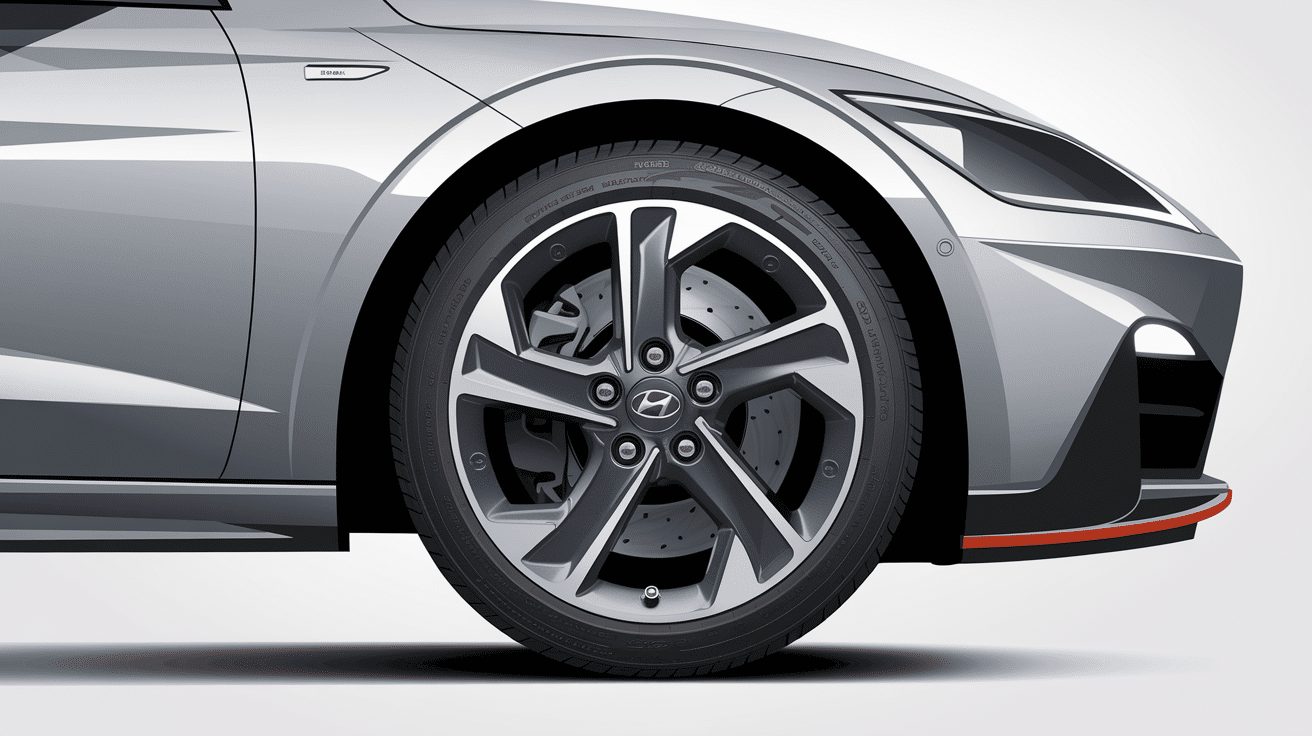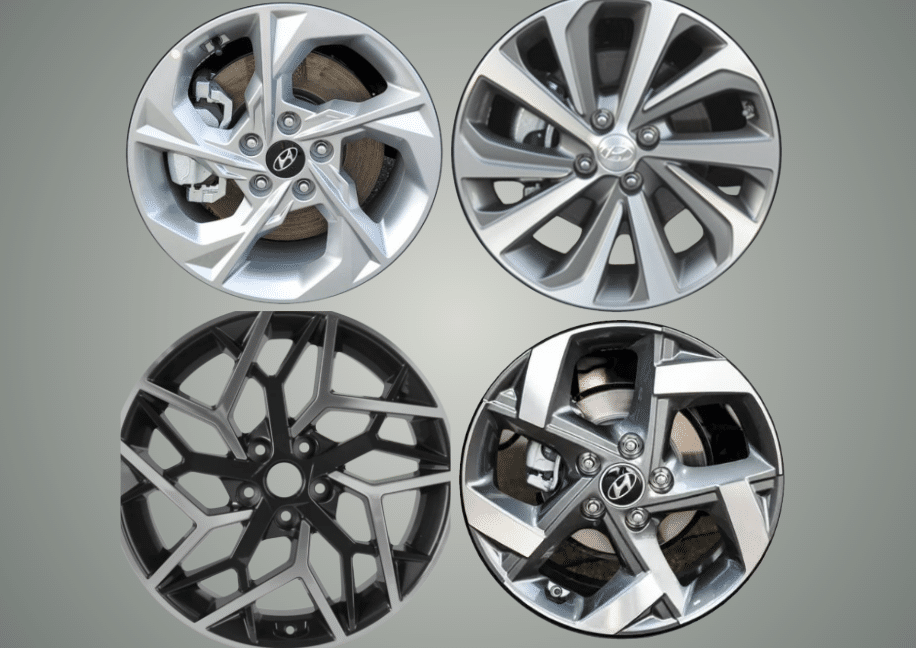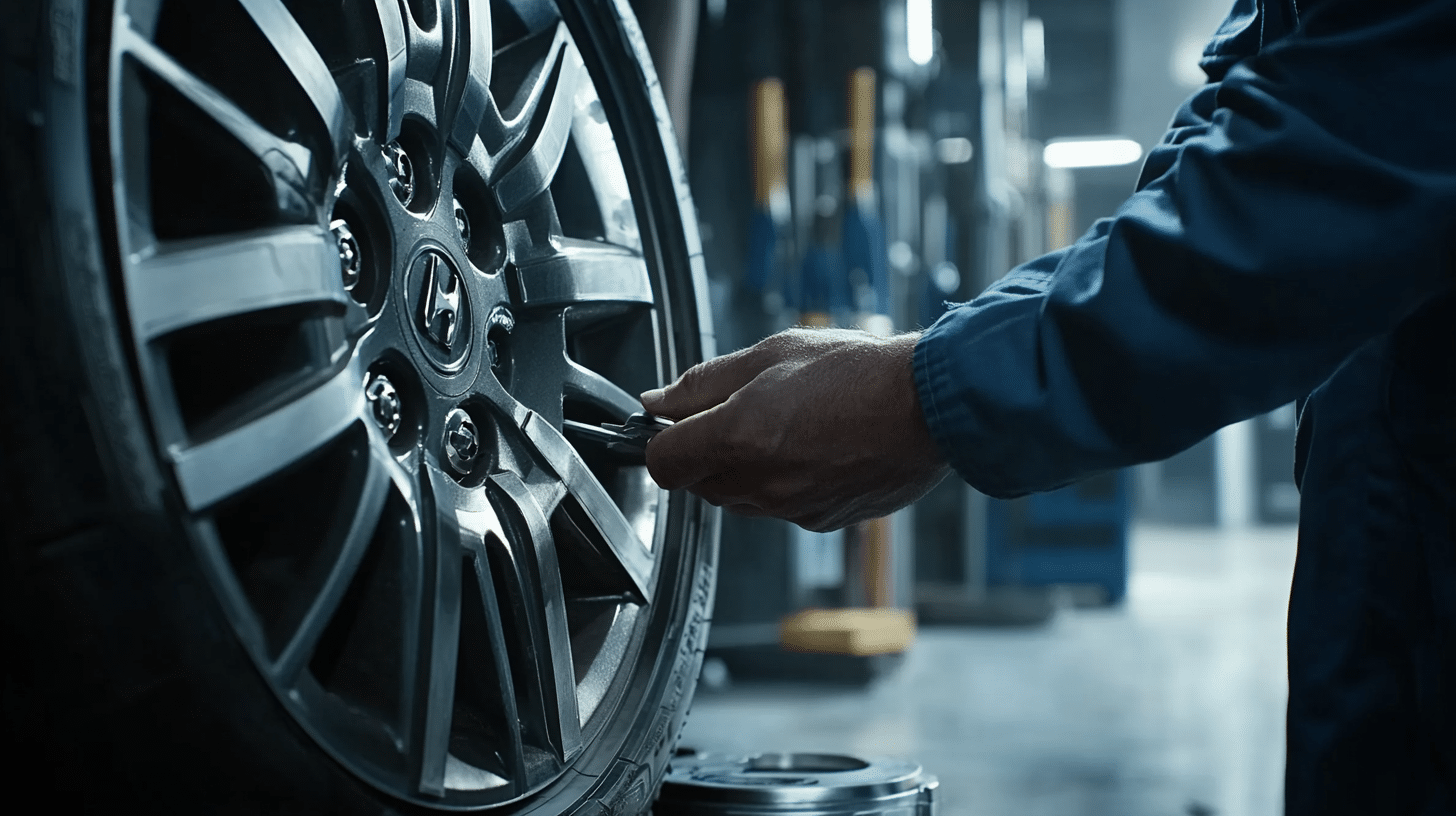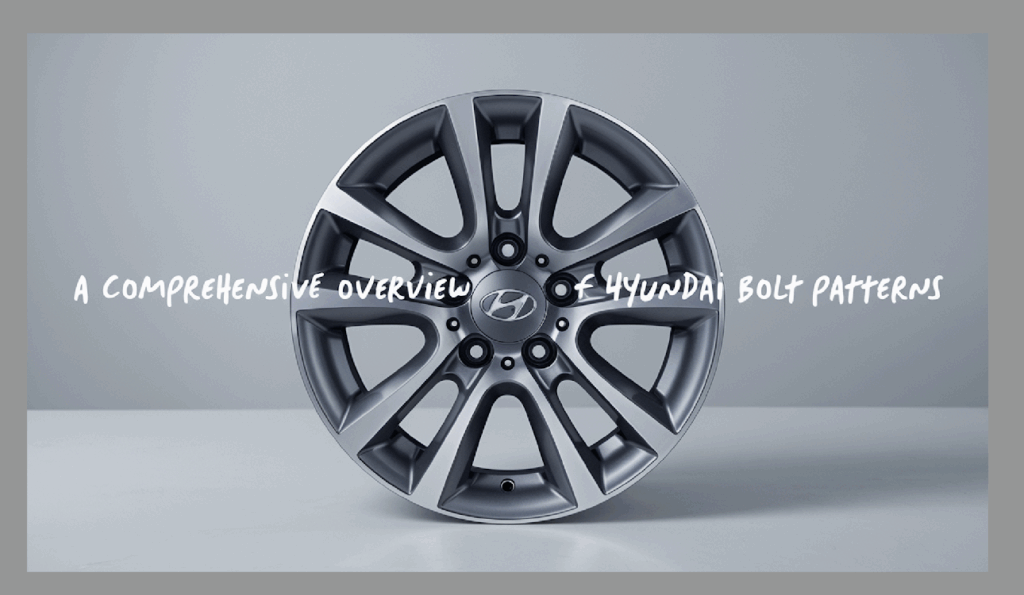In this blog, I will show you everything you need to know about Hyundai bolt patterns – from basics to specific measurements.
Through my hands-on work, I’ve learned exactly what works and what doesn’t when it comes to Hyundai wheel patterns.
From the most common bolt patterns to how to measure them, I’ll provide practical tips and advice to ensure you choose the right wheels.
Ready to find the right wheel setup for your Hyundai? Here it is!
What Is the Bolt Pattern for Hyundai?

The bolt pattern refers to the diameter of an imaginary circle drawn through the center of the wheel’s lug holes.
- Even within the same model, variations in bolt patterns can exist based on the production year or trim level. Always confirm compatibility before purchasing wheels.
- Universal wheels or wheel adapters can be used to fit wheels with different bolt patterns, but proper specifications for hub bore and wheel offset must also be considered.
The bolt pattern for Hyundai vehicles varies across models and production years but is typically standardized to ensure compatibility with a wide range of wheels.
Common Bolt Pattern:
Most Hyundai models, including the Tucson, Elantra, Santa Fe, Palisade, Sonata, and Venue, feature a 5×114.3mm (commonly referred to as 5×4.5″) bolt pattern.
This is one of the most popular configurations in the automotive industry.
Decoding Hyundai Bolt Patterns

Bolt patterns are a crucial aspect of Hyundai vehicles that determine the compatibility of wheels across models and production years.
Understanding these patterns can save you time and effort when selecting new or aftermarket wheels.
Hyundai’s Standard Bolt Patterns
- Hyundai adopts a consistent bolt pattern for many of its vehicles to simplify compatibility.
- The most common bolt pattern is 5×114.3mm (also referred to as 5×4.5″), used in models like the Tucson, Elantra (post-2007), Santa Fe, Palisade, Sonata, and Venue.
- Smaller Hyundai models like the Accent utilize a 4x100mm bolt pattern, making it distinct from larger vehicles in Hyundai’s lineup.
Production Year Variations
- Early Hyundai Elantra models (1990–2006) used a 4×114.3mm bolt pattern, but from 2007 onwards, this shifted to 5×114.3mm to align with other popular models.
- The Hyundai Venue continues the trend of using the 5×114.3mm pattern, ensuring that wheels across similar models remain compatible.
Ensuring Wheel Compatibility with Different Bolt Patterns
When considering wheels for your Hyundai, the bolt pattern is just one of several important factors:
- Pitch Circle Diameter (PCD): This defines the circle diameter through the center of the lug holes.
- Hub Bore Size: The wheel’s center bore must match the hub size to ensure proper fitment.
- Wheel Offset: Determines the positioning of the wheel on the hub. Ensure the offset falls within the recommended range for your vehicle.
- Trim and Model Year: Variations in trims or optional packages can affect compatibility. Always confirm specifications specific to your vehicle’s year and configuration.
Adapting Wheels with Different Bolt Patterns
- If you’re considering aftermarket wheels with a different bolt pattern, wheel adapters can bridge the gap.
- These adapters adjust the hub to accommodate wheels that would otherwise not fit.
- However, proper installation is critical for safety and performance.
By understanding Hyundai’s bolt pattern configurations and compatibility requirements, you can confidently upgrade or replace your wheels without unnecessary hassle.
List of The Correct Bolt Pattern for A Different Hyundai Model
| Hyundai Model | Production Years | Bolt Pattern |
|---|---|---|
| Hyundai Tucson | 2005–2022 | 5×114.3mm (5×4.5″) |
| Hyundai Elantra | 1990–2006 | 4×114.3mm |
| 2007–2024 | 5×114.3mm (5×4.5″) | |
| Hyundai Accent | All Years | 4x100mm |
| Hyundai Sonata | All Years | 5×114.3mm (5×4.5″) |
| Hyundai Santa Fe | All Years | 5×114.3mm (5×4.5″) |
| Hyundai Palisade | All Years | 5×114.3mm (5×4.5″) |
| Hyundai Venue | All Years | 5×114.3mm (5×4.5″) |
How to Identify the Correct Bolt Pattern for A Specific Hyundai Model
Identifying the correct bolt pattern for a Hyundai model is crucial when replacing or upgrading wheels. The bolt pattern determines the number of lug holes and the diameter of the imaginary circle they form.
Follow these steps to ensure accuracy:
1. Check the Vehicle’s Manual
- The owner’s manual contains all necessary specifications, including the bolt pattern, wheel offset, and hub bore size.
- Refer to this guide as the primary source of information.
2. Look for Model-Specific Patterns
Hyundai models generally follow these bolt patterns:
- 5×114.3mm (5×4.5”): The most common pattern for Hyundai models such as the Tucson, Elantra (post-2007), Sonata, Santa Fe, Venue, and Palisade.
- 4x100mm or 4×114.3mm: Common in older or compact models like the Hyundai Accent and early-generation Elantra.
3. Verify the Production Year
Bolt patterns can vary across generations of the same model. For example:
- Hyundai Elantra transitioned from 4×114.3mm (pre-2007) to 5×114.3mm (2007 onward).
- Hyundai Accent consistently uses 4x100mm, even in recent models.
4. Measure the Bolt Pattern Manually
If documentation is unavailable, measure the bolt pattern by determining:
- Number of Lugs: Count the number of lug holes (usually 4, 5, or 6 for Hyundai vehicles).
- Pitch Circle Diameter (PCD): Measure the diameter of the circle formed by the lug holes. For a 5-lug pattern, measure the distance from the center of one lug to the outer edge of the opposite lug.
5. Consult Online Resources or Experts
- Online charts or manufacturer websites often provide detailed bolt pattern specifications for specific models and years.
- Automotive shops or Hyundai dealerships can also confirm the exact bolt pattern.
6. Double-check with Aftermarket Wheels
- If purchasing aftermarket wheels, ensure they match not only the bolt pattern but also other specifications like wheel offset and hub bore.
- Wheel adapters can be used to modify patterns if necessary, but proper installation is critical.
By following these steps, you can confidently identify the correct bolt pattern for your Hyundai model and avoid any compatibility issues.
Comparisons Between Hyundai and Other Brands’ Bolt Patterns with Prices
| Brand | Bolt Pattern | Typical Models | Wheel Prices (USD) |
|---|---|---|---|
| Hyundai | 5×114.3mm (5×4.5″) | Tucson, Elantra (post-2007), Santa Fe, Palisade, Sonata, Venue | $100–$300 per wheel |
| 4x100mm | Accent | $80–$200 per wheel | |
| Toyota | 5×114.3mm (5×4.5″) | Camry, RAV4, Highlander | $120–$350 per wheel |
| Honda | 5×114.3mm (5×4.5″) | Accord, CR-V, Civic (post-2015) | $110–$300 per wheel |
| 4x100mm | Civic (pre-2015), Fit | $90–$220 per wheel | |
| Nissan | 5×114.3mm (5×4.5″) | Altima, Rogue, Murano | $100–$280 per wheel |
| 4x100mm | Versa, Micra | $70–$180 per wheel | |
| Ford | 5×114.3mm (5×4.5″) | Fusion, Escape, Explorer | $120–$350 per wheel |
| Chevrolet | 5x115mm | Malibu, Equinox, Impala | $110–$300 per wheel |
| Kia | 5×114.3mm (5×4.5″) | Sorento, Sportage, Optima | $100–$280 per wheel |
How to Maintain Bold Patterns on Your Hyundai

Proper maintenance of bolt patterns is crucial to ensure the longevity and safety of your Hyundai’s wheels.
Here’s a guide to help you maintain the integrity of your vehicle’s bolt patterns:
Regularly Check Lug Nuts:
- Inspect the lug nuts periodically to ensure they are tightened to the recommended torque specifications.
- Over-tightened or loose lug nuts can damage the bolt threads or cause uneven pressure on the wheel hub.
Re-Torque After Wheel Changes:
- After replacing or rotating wheels, re-torque the lug nuts after driving 50–100 miles.
- This helps prevent loosening due to initial vibrations, ensuring a secure fit.
Avoid Cross-Threading:
- Always align the lug nuts properly when screwing them in.
- Cross-threading can damage the threads, compromising the bolt pattern and leading to expensive repairs.
Keep the Bolt Holes Clean:
- Dirt, debris, and rust can accumulate in the bolt holes, affecting the lug nut’s grip.
- Clean the bolt holes with a brush and apply anti-seize lubricant to prevent corrosion.
Use the Correct Tools:
- Always use the appropriate wrench or torque wrench when working on your Hyundai’s wheels.
- Avoid using power tools that may over-tighten or strip the lug nuts.
Replace Damaged Studs:
- If a wheel stud becomes stripped, bent, or damaged, replace it immediately to maintain proper bolt pattern alignment.
- Ignoring damaged studs can lead to uneven pressure and unsafe driving conditions.
Check for Hub and Wheel Compatibility:
- When installing aftermarket wheels, ensure the hub bore matches the wheel’s center bore to prevent misalignment.
- Use wheel spacers or adapters if required, but ensure they are installed correctly.
Inspect Wheel Alignment Regularly:
- Misaligned wheels can place uneven stress on the bolt pattern and lug nuts.
- Regular wheel alignment checks help reduce this stress and ensure even wear on the wheels.
By following these tips, you can maintain the bolt pattern on your Hyundai, ensuring safe and smooth driving while prolonging the life of your wheels and tires.
The Bottom Line
Understanding and maintaining your Hyundai’s bolt patterns is essential for ensuring safety, longevity, and optimal performance.
By keeping lug nuts properly torqued, inspecting for damage, and ensuring wheel compatibility, you can avoid unnecessary wear and costly repairs.
Hyundai’s standardized bolt patterns, like the 5×114.3mm configuration, make it easier to find compatible wheels.
By following these tips, you can confidently care for your Hyundai’s wheels, ensuring smooth drives and preserving your vehicle’s performance for years to come.
Remember, proper upkeep is key to a safe and enjoyable driving experience.


